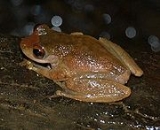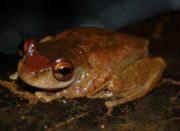
Common Mist Frog
Encyclopedia
The Common Mist Frog Litoria rheocola, is a species of tree frog
native to north-eastern Queensland
, Australia
.
, reaching a length of 3.8 centimetres (1.5 in). It is a slender frog, with long arms and legs, fully webbed feet and partly webbed hands. The hands and feet have large toe pads, wider than the fingers. The dorsal surface is a dull brown or slate, with a dark patch running from between the eyes and fading at the middle of the back. The shape of the nose is sharp, and eyes are large. The dorsal surface is a cream colour.
 The Common Mist Frog inhabits the riparian zone
The Common Mist Frog inhabits the riparian zone
of fast flowing streams in rainforests and wet sclerophyll forests of eastern Tropical North Queensland
. Males call from the edge of the streams, between rocks or in overhanging vegetation to attract mates. The call is a long "wreek". Breeding occurs throughout the year, with peak calling occurring between November and March. 46-63 eggs are laid beneath rocks, to prevent being washed away with the stream. The tadpoles are stream dwellers, and have suctorial mouth parts to allow them to survive in fast-flowing water.
Large population decreases have occurred in areas above 400m (437 yards), with many populations completely wiped out. This first occurred around 1989, south of the Daintree River
, but was replicated in the highlands north of the Daintree River in 1993.
and Queensland's Nature Conservation Act 1992
.
Tree frog
Hylidae is a wide-ranging family of frogs commonly referred to as "tree frogs and their allies". However, the hylids include a diversity of frog species, many of which do not live in trees, but are terrestrial or semi-aquatic.-Characteristics:...
native to north-eastern Queensland
Queensland
Queensland is a state of Australia, occupying the north-eastern section of the mainland continent. It is bordered by the Northern Territory, South Australia and New South Wales to the west, south-west and south respectively. To the east, Queensland is bordered by the Coral Sea and Pacific Ocean...
, Australia
Australia
Australia , officially the Commonwealth of Australia, is a country in the Southern Hemisphere comprising the mainland of the Australian continent, the island of Tasmania, and numerous smaller islands in the Indian and Pacific Oceans. It is the world's sixth-largest country by total area...
.
Physical description
The Common Mist Frog is a moderately sized frogFrog
Frogs are amphibians in the order Anura , formerly referred to as Salientia . Most frogs are characterized by a short body, webbed digits , protruding eyes and the absence of a tail...
, reaching a length of 3.8 centimetres (1.5 in). It is a slender frog, with long arms and legs, fully webbed feet and partly webbed hands. The hands and feet have large toe pads, wider than the fingers. The dorsal surface is a dull brown or slate, with a dark patch running from between the eyes and fading at the middle of the back. The shape of the nose is sharp, and eyes are large. The dorsal surface is a cream colour.
Ecology and behaviour

Riparian zone
A riparian zone or riparian area is the interface between land and a river or stream. Riparian is also the proper nomenclature for one of the fifteen terrestrial biomes of the earth. Plant habitats and communities along the river margins and banks are called riparian vegetation, characterized by...
of fast flowing streams in rainforests and wet sclerophyll forests of eastern Tropical North Queensland
Tropical North Queensland
Tropical North Queensland is general term referring to varying regions of the northern part of the Australian state of Queensland. The generally accepted definition is an area from about the city of Mackay north to the tip of Cape York....
. Males call from the edge of the streams, between rocks or in overhanging vegetation to attract mates. The call is a long "wreek". Breeding occurs throughout the year, with peak calling occurring between November and March. 46-63 eggs are laid beneath rocks, to prevent being washed away with the stream. The tadpoles are stream dwellers, and have suctorial mouth parts to allow them to survive in fast-flowing water.
Large population decreases have occurred in areas above 400m (437 yards), with many populations completely wiped out. This first occurred around 1989, south of the Daintree River
Daintree River
The Daintree River runs through the Daintree Rainforest in the Cape Tribulation region of Queensland in northern Australia. It is located about 100 kilometres northwest of Cairns in far north tropical Queensland and drains an area of 2,125 square kilometres. The river, along with the Daintree...
, but was replicated in the highlands north of the Daintree River in 1993.
Conservation status
It is listed as Endangered under both the IUCN Red ListIUCN Red List
The IUCN Red List of Threatened Species , founded in 1963, is the world's most comprehensive inventory of the global conservation status of biological species. The International Union for Conservation of Nature is the world's main authority on the conservation status of species...
and Queensland's Nature Conservation Act 1992
Nature Conservation Act 1992
The Nature Conservation Act 1992 is an act of the Parliament of Queensland that provides for the legislative protection of Queensland's threatened biota. As originally published, it provided for biota to be declared presumed extinct, endangered, vulnerable, rare or common...
.

